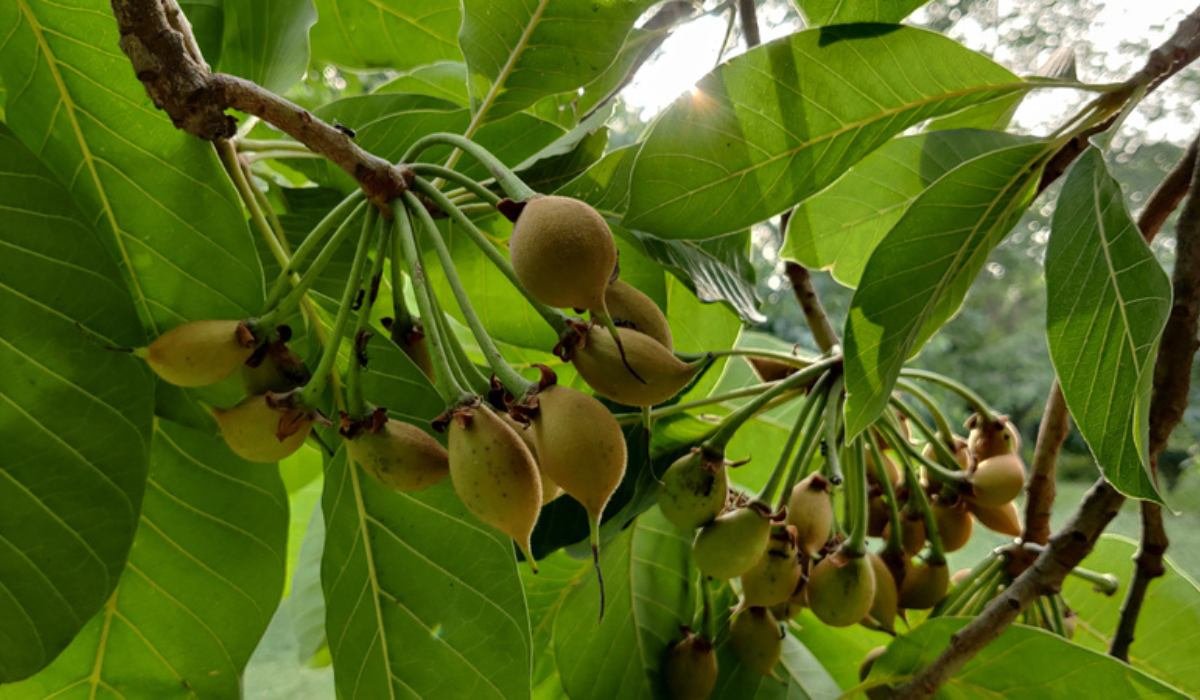MAHUA
1. Introduction
- Many Adivasi communities like Munda, Gond, Oraon, Baiga, Ho & Santhal depend on Mahua even before they are born.
- These people live by the tropical deciduous forests of India, spreading from the drier parts of Gujarat in the west to the Chotanagpur Plateau in the east.
2. Mahua-Omnipresent
- From birth, through marriage, till funeral, mahua is intertwined with cultural life.
- In daily life, mahua is omnipresent from food to fodder, medicine to alcohol.
- Would-be mothers of the tribal people are fed a simple chutney made of mahua flowers which are believed to be healthy.
- Mahua is a part of wedding rituals & mahua liquor is served at the ceremony.
| Mahua (Madhuca Indica), the seed does not spread its roots in the soil but also blooms within the Adivasi. For them, "Mahua is not a tree, it's our way of life". |
3. Uses
- Like Mahua flowers, mahua seeds are non-timber forest products.
- A major portion of the seeds collected by the tribals is solid in the one or two oil presses of nearby towns & the rest is for household consumption.
- The oil from the seed is used to light lamps or in cooking.
- It is used for treating skin disease, rheumatism, bilious fever, and constipation among other things.
- Seeds & flowers are galactagogues which boost breast milk production & are good for new mothers.
- After oil extraction, the leftover seed cake is utilised as an insecticide, cattle feed or manure.

4. Backed by Science
- The seeds yield 34-37% of oil.
- Locals use the oil as an adulterant of 'Ghee' after some rudimentary processing.
- World Health Organization (WHO) don't consider this as edible in its raw form, as it contains aflatoxin, a toxic component.
- The processing of the oil can get rid of the aflatoxin & makes it edible as per safety standards.
- More than oil, the cocoa butter extender prepared from mahua seed oil is a prized product, which is used to make chocolate / other confectionaries.
- This oil is a potent biodiesel. The researchers have developed & tested the Mahua Oil Biodiesel (MOB) with promising results.
- These products offer a wonderful scope that can alter the socio-economic conditions of the tribal communities.
- The fuel properties adhere to international quality standards.
- MOB or blends of MOB with diesel is a good competitor for diesel, with reliable performance & lower emissions.
- The flour prepared with the leftovers is suitable for making bakery products.
- Due to the presence of foaming agents, it is used for preparing laundry soaps.
- A few studies have identified the chemical components of the seeds & developed bio-insecticides & bio-pesticides.
5. Boon / Ban
- India has a huge opportunity to materialise the potential of mahua seeds, but there remain some serious caveats.
| The price of MOB and its blends could vary between Rs. 48 - Rs.60 per litre, whereas the price of conventional diesel was around Rs.65 per litre in 2017. It's unclear what price for mahua seeds was considered and how that could have impacted the calculation. Five years later, when diesel price is now hovering around Rs.100 per litre and India is mulling over alternatives, the importance of mahre biodiesel becomes more relevant. |
- For mahua oil or butter, research hasn't shown us any direction, but the existing market for them has. There exists a non-tribal market for mahua oil and butter.
- Anyone can buy it from leading E-Commerce sites, where mahua oil price varies from Rs.65 - Rs.1700 per litre, presumably depending on its usefulness and quality, and mahua butter is available at Rs.125 per 100 grams.
- If this non-tribal market base can be expanded and popularised, then it can provide better economic opportunities to the Adivasis. Considering they will receive a fair share of the profit, it can strengthen and sustain their traditional livelihoods.
6. Excess
- Mahua is a slow-growing tree and its population is declining in multiple pockets throughout its range.
- It's been speculated that seed harvesting practices by Adivasi communities may be the reason for this decline.
- The ripe mahua fruits fall from the trees and tribals collect these seeds from the ground below the canopy where the chances of seed germination and seedling survival are negligible.
| Due to the high concentration of seeds here, there are susceptible to fungal attack, grazing and other threats, and face high mortality. This phenomenon is called the seed shadow effect. |
- If not collected, the seeds are going to rot & not add to the population.
- Since the oil content of mature seeds is higher, fruits were not plucked.
- The seed harvesting practice is very much non-invasive for the trees & highly sustainable.
7. Epilogue
- The composite picture is bright & not gloomy. It can be concluded that at least seed harvest is not detrimental to the mahua population.
- Many seeds are left untouched & not grazed.
- There lies an opportunity to encash the non-tribal market for mahua seed-derived products, without exerting any impact on trees.
- Eliminating the exploitation & realising the outside market presents a win-win opportunity for the tribals & trees will go a long way.
- Mahua is an immensely important tree species for the functioning of the dry forest ecosystem & for the Adivasis.
- Since mahua trees are maintained as an agroforestry practice, it helps to maintain the local biodiversity.
For Prelims & Mains
|
For Prelims: Mahua, Mahua Oil Biodiesel (MOB),
For Mains:
1. What is Mahua and discuss its importance in the livelihood of Indian Tribes. (250 Words)
|
Source: Down to earth




